Middleton W.M. (ed.) Reference Data for Engineers: Radio, Electronics, Computer and Communications
Подождите немного. Документ загружается.

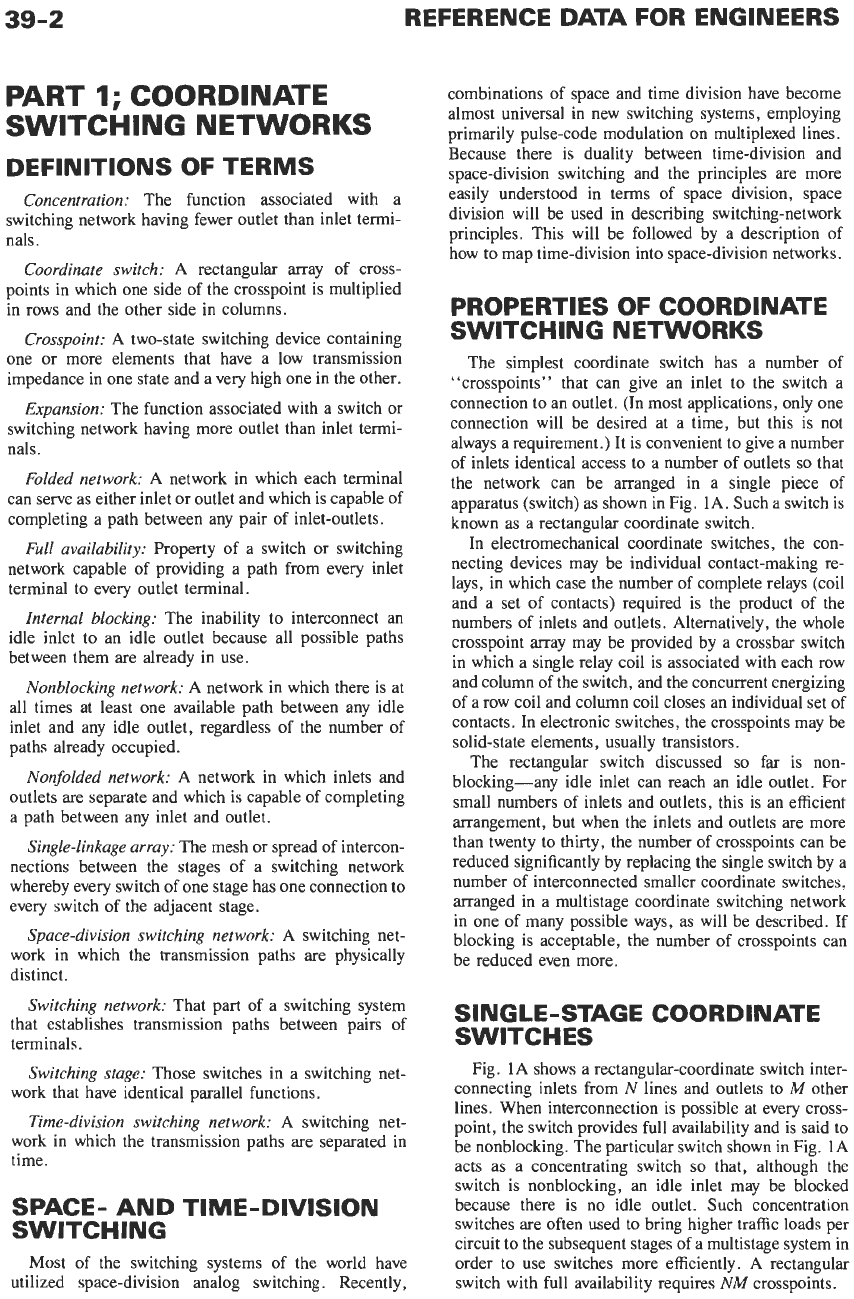
39-2
REFERENCE DATA FOR ENGINEERS
PART
I;
COORDINATE
SWITCHING NETWORKS
DEFINITIONS
OF
TERMS
Concentration:
The function associated with a
switching network having fewer outlet than inlet termi-
nals.
Coordinate switch:
A rectangular array of cross-
points in which one side of the crosspoint is multiplied
in rows and the other side in columns.
Crosspoint:
A
two-state switching device containing
one or more elements that have a low transmission
impedance in one state and a very high one in the other.
Expansion:
The function associated with a switch or
switching network having more outlet than inlet termi-
nals.
Folded network:
A network in which each terminal
can serve as either inlet or outlet and which is capable of
completing a path between any pair of inlet-outlets.
Full availability:
Property of a switch or switching
network capable of providing a path from every inlet
terminal to every outlet terminal.
Internal blocking:
The inability to interconnect an
idle inlet to an idle outlet because all possible paths
between them are already in use.
Nonblocking network:
A network in which there is at
all times at least one available path between any idle
inlet and any idle outlet, regardless of the number of
paths already occupied.
Nonfolded network:
A network in which inlets and
outlets are separate and which is capable of completing
a path between any inlet and outlet.
Single-linkage array:
The mesh
or
spread of intercon-
nections between the stages of a switching network
whereby every switch
of
one stage has one connection to
every switch of the adjacent stage.
Space-division switching network:
A switching net-
work in which the transmission paths are physically
distinct.
Switching network:
That part of a switching system
that establishes transmission paths between pairs of
terminals.
Switching stage:
Those switches in a switching net-
work that have identical parallel functions.
Time-division switching network:
A switching net-
work in which the transmission paths are separated in
time.
SPACE- AND TIME-DIVISION
SWITCHING
Most of the switching systems of the world have
utilized space-division analog switching. Recently,
combinations of space and time division have become
almost universal in new switching systems, employing
primarily pulse-code modulation on multiplexed lines.
Because there is duality between time-division and
space-division switching and the principles are more
easily understood in terms of space division, space
division will be used in describing switching-network
principles. This will be followed by a description of
how to map time-division into space-division networks.
PROPERTIES OF COORDINATE
SWITCHING NETWORKS
The simplest coordinate switch has a number of
“crosspoints” that can give an inlet to the switch a
connection to an outlet. (In most applications, only one
connection will be desired at a time, but this is not
always a requirement.) It is convenient to give a number
of inlets identical access to a number of outlets
so
that
the network can be arranged in a single piece of
apparatus (switch) as shown in Fig. 1A. Such a switch is
known as a rectangular coordinate switch.
In electromechanical coordinate switches, the con-
necting devices may be individual contact-making re-
lays, in which case the number of complete relays (coil
and a set of contacts) required is the product of the
numbers of inlets and outlets. Alternatively, the whole
crosspoint array may be provided by a crossbar switch
in which a single relay coil is associated with each row
and column of the switch, and the concurrent energizing
of a row coil and column coil closes an individual set
of
contacts. In electronic switches, the crosspoints may be
solid-state elements, usually transistors.
The rectangular switch discussed
so
far is non-
blocking-any idle inlet can reach an idle outlet. For
small numbers of inlets and outlets, this is an efficient
arrangement, but when the inlets and outlets are more
than twenty to thirty, the number of crosspoints can be
reduced significantly by replacing the single switch by a
number of interconnected smaller coordinate switches,
arranged in a multistage coordinate switching network
in one of many possible ways, as will be described.
If
blocking is acceptable, the number
of
crosspoints can
be reduced even more.
SINGLE-STAGE COORDINATE
SWITCHES
Fig.
1A
shows a rectangular-coordinate switch inter-
connecting inlets from
N
lines and outlets to
M
other
lines. When interconnection is possible at every cross-
point, the switch provides full availability and is said to
be nonblocking. The particular switch shown in Fig.
1A
acts as a concentrating switch
so
that, although the
switch is nonblocking, an idle inlet may be blocked
because there is no idle outlet. Such concentration
switches are often used to bring higher traffic loads per
circuit to the subsequent stages
of
a multistage system in
order to use switches more efficiently. A rectangular
switch with full availability requires
NM
crosspoints.
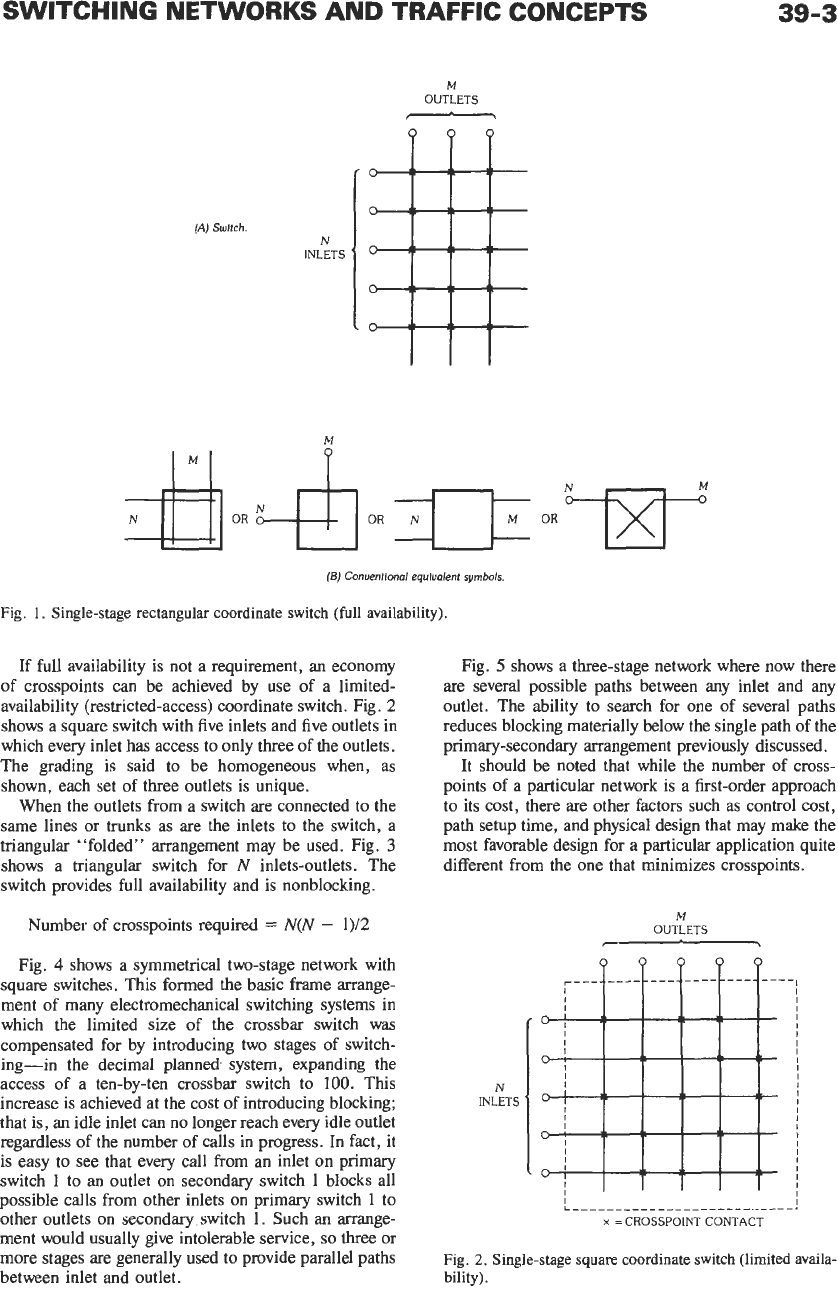
SWITCHING NETWORKS AND TRAFFIC CONCEPTS
N
INLETS
’
39-3
r
(A)
Swltch.
N
INLETS
’
OR
I
M
OUTLETS
OR
(E)
Conuentlonal equlualent
symbols.
Fig.
1.
Single-stage rectangular coordinate switch (full availability).
If
full availability is not a requirement,
an
economy
of crosspoints can be achieved by use
of
a limited-
availability (restricted-access) coordinate switch. Fig.
2
shows a square switch with five inlets and five outlets in
which every inlet has access to only three of the outlets.
The grading is said to be homogeneous when, as
shown, each set of three outlets is unique.
When the outlets from
a
switch
are
connected to the
same lines or trunks as
are
the inlets to the switch, a
triangular “folded” arrangement may be used. Fig.
3
shows a triangular switch for
N
inlets-outlets. The
switch provides full availability and is nonblocking.
Number
of
crosspoints required
=
N(N
-
1)/2
Fig.
4
shows a symmetrical two-stage network with
square switches. This formed the basic frame arrange-
ment of many electromechanical switching systems in
which the limited size
of
the crossbar switch was
compensated for by introducing two stages of switch-
ing-in the decimal planned- system, expanding the
access of a ten-by-ten crossbar switch
to
100.
This
increase
is
achieved at the cost of introducing blocking;
that is, an idle inlet can
no
longer reach every idle outlet
regardless of the number of calls in progress. In fact, it
is easy to see that every call from an inlet
on
primary
switch
1
to an outlet on secondary switch
1
blocks all
possible calls from other inlets
on
primary switch
1
to
other outlets on secondary switch
1.
Such
an
arrange-
ment would usually give intolerable service,
so
three
or
more stages
are
generally used to provide parallel paths
between inlet and outlet.
OR
NwM
Fig.
5
shows a three-stage network where now there
are several possible paths between any inlet and any
outlet. The ability to search for one of several paths
reduces blocking materially below the single path of the
primary-secondary arrangement previously discussed.
It should be noted that while the number of cross-
points of a particular network is a first-order approach
to its cost, there
are
other factors such
as
control cost,
path setup time, and physical design that may make the
most favorable design for
a
particular application quite
different from the one that minimizes crosspoints.
M
OUTLETS
x
=CROSSPOINT CONTACT
Fig.
2.
Single-stage square
coordinate
switch
(limited availa-
bility).
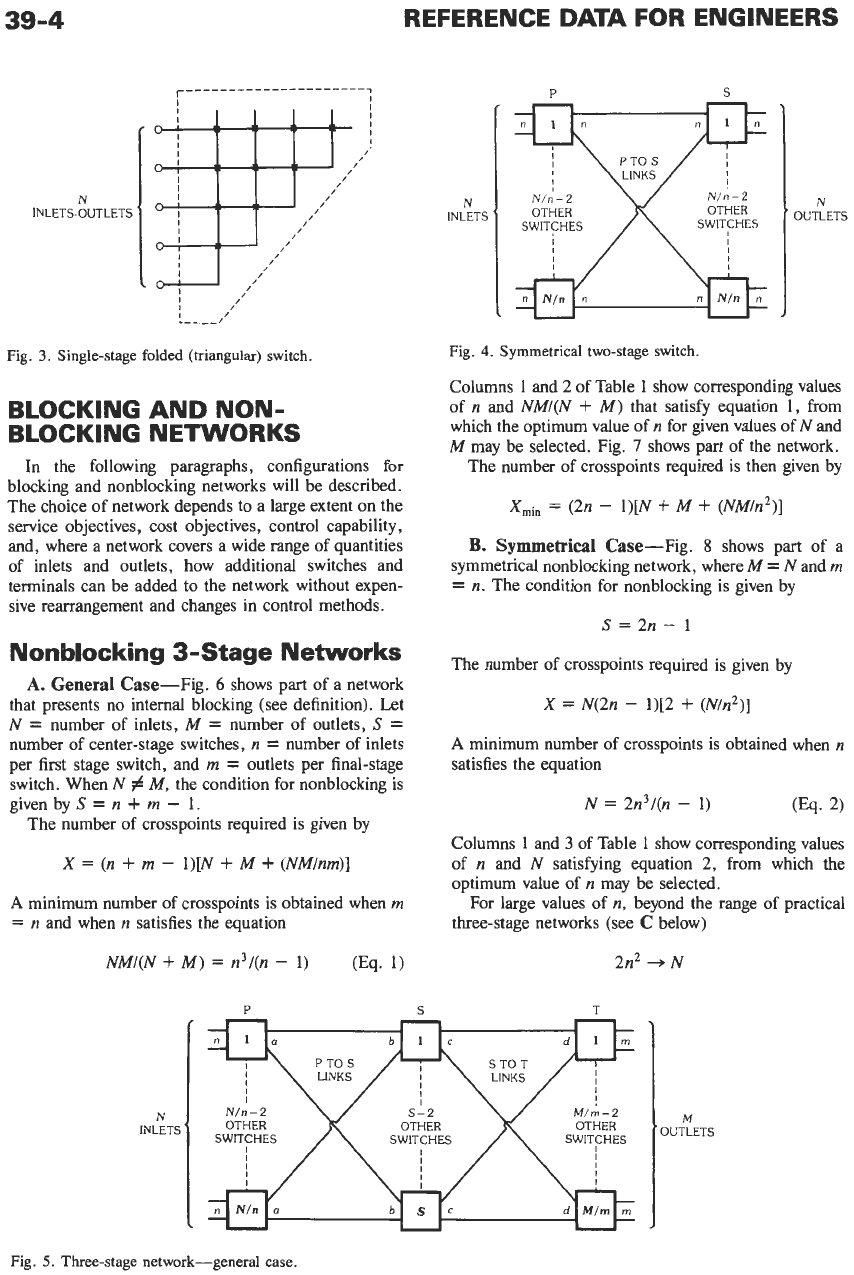
39-4
REFERENCE DATA FOR ENGINEERS
N
INLETS-OUTLETS
Fig.
3.
Single-stage folded (triangular) switch.
BLOCKING AND NON-
BLOCKING NETWORKS
In
the following paragraphs, configurations for
blocking and nonblocking networks will be described.
The choice of network depends to a large extent
on
the
service objectives, cost objectives, control capability,
and, where a network covers a wide range
of
quantities
of inlets and outlets, how additional switches and
terminals can be added
to
the network without expen-
sive rearrangement and changes in control methods.
Nonblocking 3-Stage Networks
A.
General
Case-Fig.
6
shows part
of
a network
that presents no internal blocking (see definition). Let
N
=
number of inlets,
M
=
number of outlets,
S
=
number
of
center-stage switches,
n
=
number of inlets
per first stage switch, and
rn
=
outlets per final-stage
switch. When N
#
M,
the condition for nonblocking is
givenbyS=n+rn-
1.
The number of crosspoints required is given by
X
=
(n
+
rn
-
1)[N
+
M
+
(NMlnrn)]
A
minimum number
of
crosspoints is obtained when
rn
=
n
and when
n
satisfies the equation
NM/(N
+
M)
=
n3/(n
-
1)
(Eq. 1)
N
INLETS
N
INLETS
P
S
N
OUTLETS
Fig.
4.
Symmetrical two-stage switch.
Columns
1
and 2 of Table
1
show corresponding values
of
n and NMI(N
+
M)
that satisfy equation 1, from
which the optimum value of
n
for given values of N and
M
may be selected. Fig.
7
shows part
of
the network.
The number
of
crosspoints required is then given by
Xmin
=
(2n
-
1)[N
+
M
+
(NM/n2)]
B.
Symmetrical Case-Fig.
8
shows part of a
symmetrical nonblocking network, where
M
=
Nand
rn
=
n.
The condition for nonblocking is given by
S=2n-1
The number of crosspoints required is given by
X
=
N(2n
-
1)[2
+
(N/n2)]
A
minimum number of crosspoints is obtained when
n
satisfies the equation
N
=
2n3/(n
-
1)
(Eq.
2)
Columns 1 and
3
of Table 1 show corresponding values
of
n
and N satisfying equation 2, from which the
optimum value of
n
may be selected.
For large values
of
n,
beyond the range of practical
three-stage networks (see
C
below)
2n2
+
N
P
S
T
M
OUTLETS
Fig.
5.
Three-stage network-general case.

39-5
Fig.
6.
Nonblocking three-stage network.
Columns
1
and
4
of Table 1 show corresponding values
of
n
and
N
satisfying the equation
N
=
2n2
(Eq.
3)
The optimum value of
n
selected by using column
3
is
either equal to or one less than the value indicated by
column
4.
C. Comparison
of
3-Stage Network and Single-
Stage Switch-A
single-stage, full-access switch is
inherently nonblocking. The most favorable non-
blocking three-stage network requires fewer than
NM
crosspoints if
NM/(N
+
M)
>
n2(2n
-
l)/(n
-
1)’
Table
2
shows, for some practical values of
n,
the
limiting value of
NMI(N
+
hf)
below which a single-
stage switch requires fewer crosspoints.
Table
3
compares single-stage switches and three-
stage symmetrical nonblocking networks for typical
values
of
N
and
n,
where
Nln
is integral (see
D
below),
to illustrate the trends
of
design choices.
D.
Practical Nonblocking 3-Stage Network with
Minimum Crosspoints-When
a nonblocking net-
work with a minimum number of crosspoints is sought,
the indicated optimum value of inlets,
n,
per primary-
stage switch may be such that
Nln
is not integral. The
desired result may be achieved by providing some of the
primary-stage and tertiary-stage switches with
(n
-
1)
inlets and outlets, respectively, by adjusting the sizes of
the secondary-stage switches, and by superimposing
two sets
of
interstage linkages.
Fig.
7.
Nonblocking three-stage network with minimum
crosspoints.
The method is illustrated in Fig. 9, a nonblocking
network for
100
inlets and
100
outlets requiring a
minimum number of crosspoints. The value
n
=
6
is
selected from column
3
of Table
1.
The nearest multiple
of
6
that exceeds 100 is
102.
Thus,
17
primary-stage
switches are required, 15 with
6
inlets each and 2 with
5
inlets. The larger switches require
2n
-
1
=
11
outlets
each, cross-linked
to
11 secondary-stage switches (links
shown by continuous lines). The smaller switches
require
2n
-
2
=
10
outlets each, cross-linked to
10
only of the secondary-stage switches (links shown by
dashed lines). Thus, the secondary-stage switches also
are
of
two sizes. The total number of crosspoints is
5291 (as compared with
5423
for a nonblocking net-
work for
102
inlets and outlets, with
n
=
6).
The
crosspoint saving may not be worth the added control
complexity.
E. Extension to 5-Stage and 7-Stage Net-
works-If
the number of inlets and outlets on each
secondary-stage switch of a three-stage network is
large, it
is
advantageous
to
use a five-stage network.
One possible arrangement is shown in Fig. 10, in which
each secondary switch of a symmetrical three-stage
network conforming to Fig.
8
is expanded into a
nonblocking three-stage subnetwork.
If
N
>
160, a five-stage nonblocking network can be
designed-by judicious selection of parameters
n
and
a-which requires fewer crosspoints than the most
favorable nonblocking three-stage network. The advan-
tage increases slowly with
N;
at
N
=
240,
the advantage
is
less than
5%.
The number of crosspoints is given by
X
=
N(2n
-
1){2
+
(2a
-
1)[(2/n)
+
(N/n’a’)]}
TABLE
1.
RELATIONSHIP
OF
n,
N,
AND
M
IN NONBLOCKING 3-STAGE
NETWORKS
n
N
(Eq.
2)
N
(Eq.
3)
2
3
4
5
6
I
8
9
10
11
12
8.0
13.5
21.3
32.2
43.2
57.2
73.1
91.1
111.1
133.1
157.1
16*
27
*
42.7
62.5
86.4
114.3
146.3
182.2
222.2
266.2
314.2
8
18
32
50
72
98
128
162
200
242
288
*The only two integral solutions
of
equation
2.
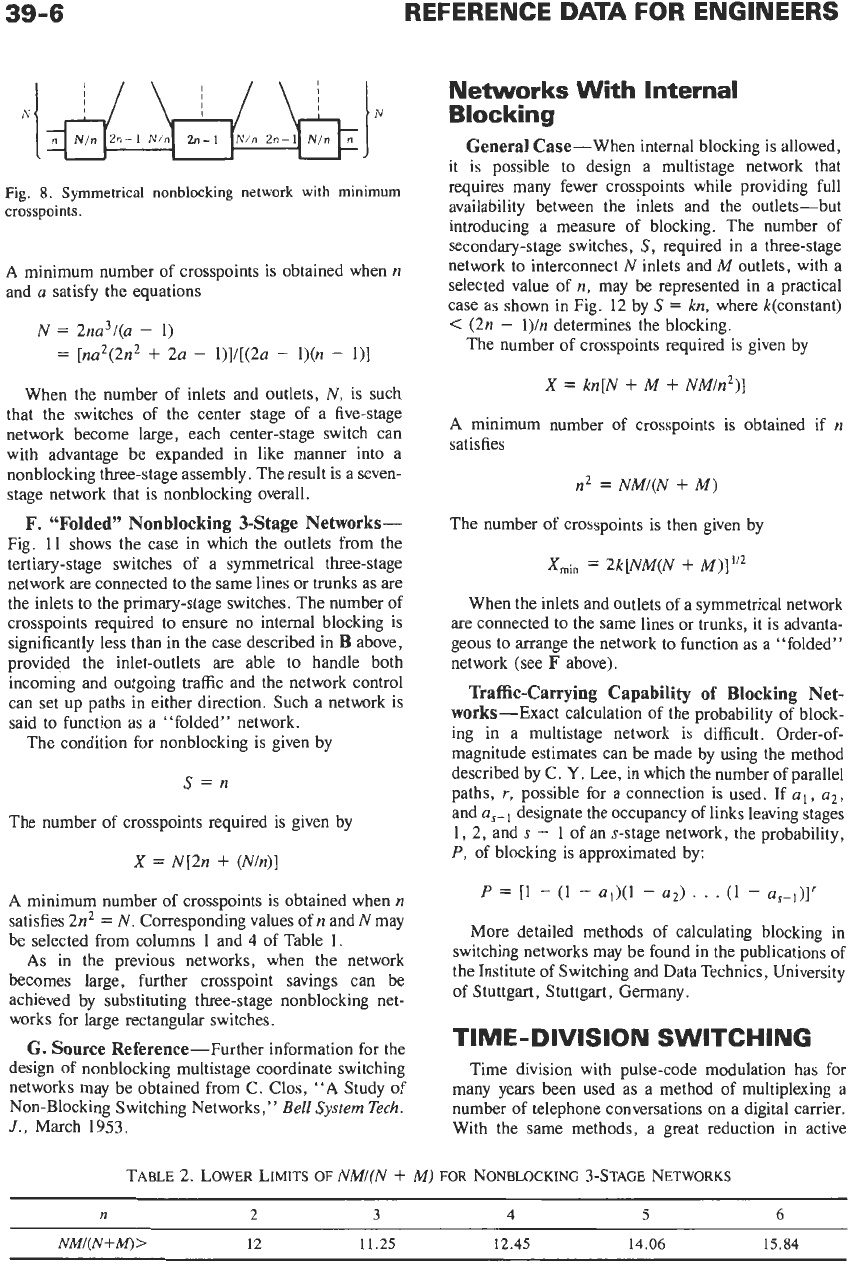
39-6
REFERENCE
DATA
FOR ENGINEERS
N
Fig.
8.
Symmetrical nonblocking network
with
minimum
crosspoints.
A
minimum number of crosspoints is obtained when
n
and
a
satisfy the equations
N
=
2na3/(a
-
1)
=
[na2(2n2
+
2a
-
1)]/[(2a
-
l)(n
-
I)]
When the number of inlets and outlets, N, is such
that the switches of the center stage of a five-stage
network become large, each center-stage switch can
with advantage be expanded in like manner into a
nonblocking three-stage assembly. The result is a seven-
stage network that is nonblocking overall.
F.
“Folded” Nonblocking 3-Stage Networks-
Fig. 11 shows the case in which the outlets from the
tertiary-stage switches of a symmetrical three-stage
network are connected to the same lines or trunks as are
the inlets
to
the primary-stage switches. The number of
crosspoints required to ensure no internal blocking is
significantly less than in the case described in
B
above,
provided the inlet-outlets are able to handle both
incoming and outgoing traffic and the network control
can set up paths in either direction. Such a network is
said to function as a “folded” network.
The condition for nonblocking is given by
S=n
The number of crosspoints required is given by
X
=
N[2n
+
(N/n)]
A
minimum number of crosspoints is obtained when
n
satisfies
2n2
=
N. Corresponding values of
n
and
N
may
be selected from columns
1
and
4
of Table
1.
As
in the previous networks, when the network
becomes large, further crosspoint savings can be
achieved by substituting three-stage nonblocking net-
works for large rectangular switches.
G.
Source Reference-Further information for the
design
of
nonblocking multistage coordinate switching
networks may be obtained from C. Clos,
“A
Study of
Non-Blocking Switching Networks,”
Bell
System
Tech.
J..
March 1953.
Networks
With
Internal
Blocking
General Case-When internal blocking is allowed,
it is possible to design a multistage network that
requires many fewer crosspoints while providing full
availability between the inlets and the outlets-but
introducing a measure of blocking. The number of
secondary-stage switches,
S,
required in a three-stage
network to interconnect N inlets and
M
outlets, with a
selected value of
n,
may be represented in a practical
case as shown in Fig. 12 by
S
=
kn, where k(constant)
<
(2n
-
l)/n
determines the blocking.
The number of crosspoints required is given by
X
=
kn[N
+
M
+
NM/n2)]
A
minimum number of crosspoints is obtained if
n
satisfies
n2
=
NM/(N
+
M)
The number of crosspoints is then given by
Xmin
=
2k[NM(N
i-
M)]”2
When the inlets and outlets
of
a symmetrical network
are connected to the same lines or trunks, it is advanta-
geous to arrange the network to function as a “folded”
network (see
F
above).
Traffic-Carrying Capability of Blocking
Net-
works-Exact calculation
of
the probability of block-
ing in a multistage network is difficult. Order-of-
magnitude estimates can be made by using the method
described by C.
Y.
Lee, in which the number of parallel
paths,
r,
possible for a connection is used. If
a,, a2,
and
a,-,
designate the occupancy of links leaving stages
1,
2,
and
s
-
1
of an s-stage network, the probability,
P,
of
blocking is approximated by:
P
=
[l
-
(1
-
a,)(l
-
a,)
.
. .
(1
-
a5-l)]r
More detailed methods of calculating blocking in
switching networks may be found in the publications
of
the Institute of Switching and Data Technics, University
of Stuttgart, Stuttgart, Germany.
TIME-DIVISION SWITCHING
Time division with pulse-code modulation has for
many years been used as a method
of
multiplexing a
number of telephone conversations on a digital carrier.
With the same methods, a great reduction in active
TABLE
2.
LOWER LIMITS
OF
NMI(N
f
M)
FOR
NONBLOCKING 3-STAGE NETWORKS
n
2
3
4
5
6
NM/(N+M)>
12
11.25 12.45 14.06 15.84
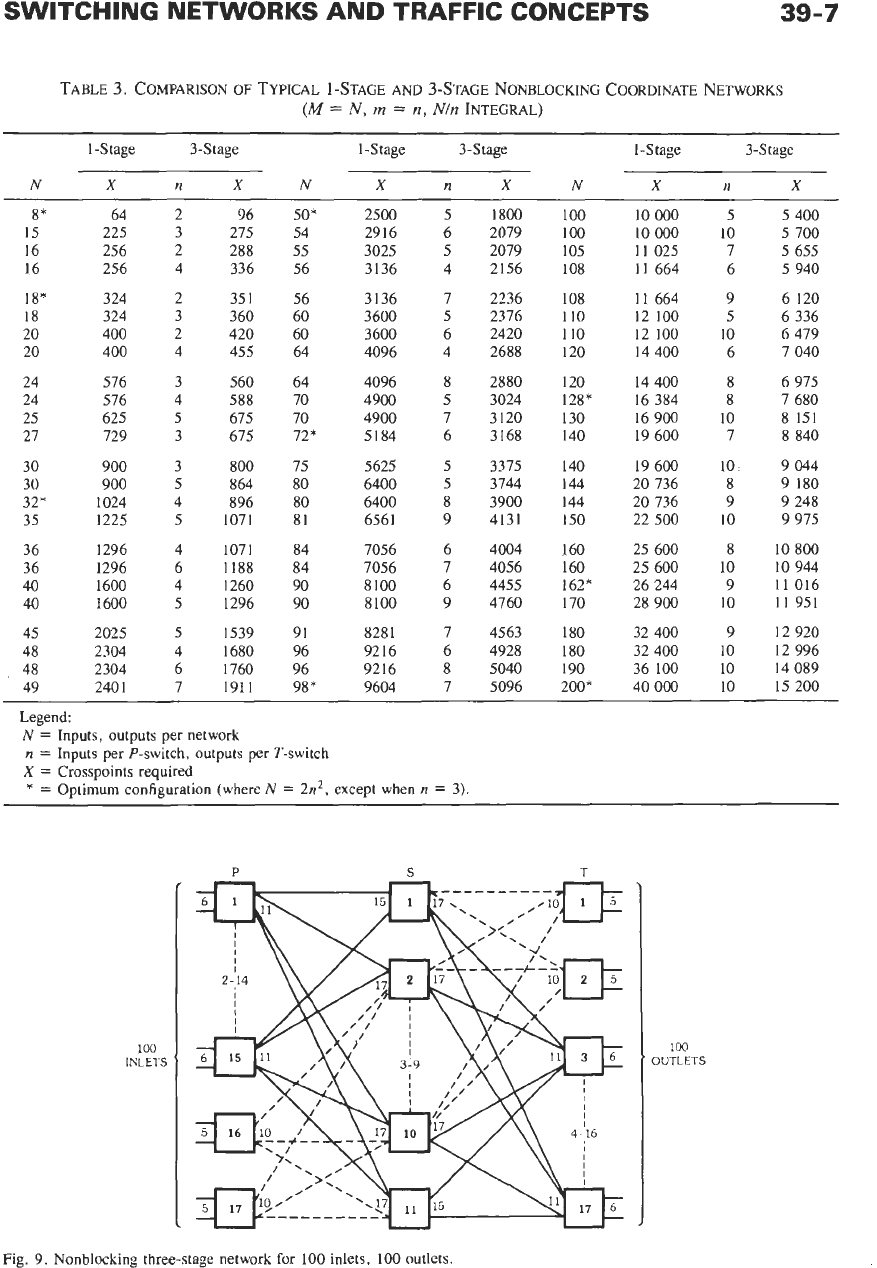
SWITCHING NETWORKS AND TRAFFIC CONCEPTS
39-7
TABLE
3.
COMPARISON
OF
TYPICAL
1
-STAGE AND 3-STAGE
NONBLOCKING
COORDINATE
NETWORKS
(M
=
N,
m
=
n,
Nln
INTEGRAL)
~
1-Stage 3-Stage 1-Stage 3-Stage I-Stage 3-Stage
N
X
n
X
N
X
n
X
N
X
n
X
8* 64 2
15 225 3
16 256 2
16 256 4
18* 324 2
18 324 3
20 400 2
20 400 4
24 576 3
24 576 4
25 625
5
27 729 3
30 900 3
30 900
5
32' 1024 4
35 1225
5
36 1296 4
36 1296 6
40 1600 4
40 1600
5
45 2025
5
48 2304 4
48 2304 6
49 240 1 7
96
275
288
336
35 1
360
420
455
560
588
675
615
800
864
896
1071
1071
1188
1260
1296
1539
1680
1760
1911
50*
2500
5
54 2916 6
55
3025
5
56 3136 4
56 3136 7
60 3600
5
60 3600 6
64 4096 4
64 4096 8
70 4900
5
70 4900 7
72* 5184 6
75 5625
5
80 6400
5
80 6400 8
81 6561 9
84 7056 6
84 1056 7
90 8100 6
90 8100 9
91 828 1 7
96 9216 6
96 9216 8
98
*
9604 7
1800
2079
2079
2156
2236
2376
2420
2688
2880
3024
3120
3168
3375
3744
3900
4131
4004
4056
4455
4760
4563
4928
5040
5096
100
100
105
108
108
110
110
120
120
128*
130
140
140
144
144
150
160
160
162*
170
180
180
190
200"
10 000
10
000
11 025
11 664
11 664
12
100
12 100
14 400
14 400
16 384
16 900
19 600
19 600
20 736
20 736
22 500
25 600
25 600
26 244
28 900
32 400
32 400
36 100
40
000
5
10
7
6
9
5
10
6
8
8
10
7
10:
8
9
10
8
10
9
10
9
10
10
10
5
400
5
700
5
655
5
940
6 120
6 336
6 479
7 040
6 975
7 680
8 151
8 840
9 044
9 180
9 248
9 975
10
800
10
944
11 016
11 951
12 920
12 996
14 089
15 200
Legend:
N
=
Inputs, outputs per network
n
=
Inputs per P-switch, outputs per T-switch
X
=
Crosspoints required
*
=
Optimum configuration (where
N
=
2nZ, except when
n
=
3).
100
INLETS
100
OUTLETS
Fig. 9. Nonblocking three-stage network for 100 inlets,
100
outlets.
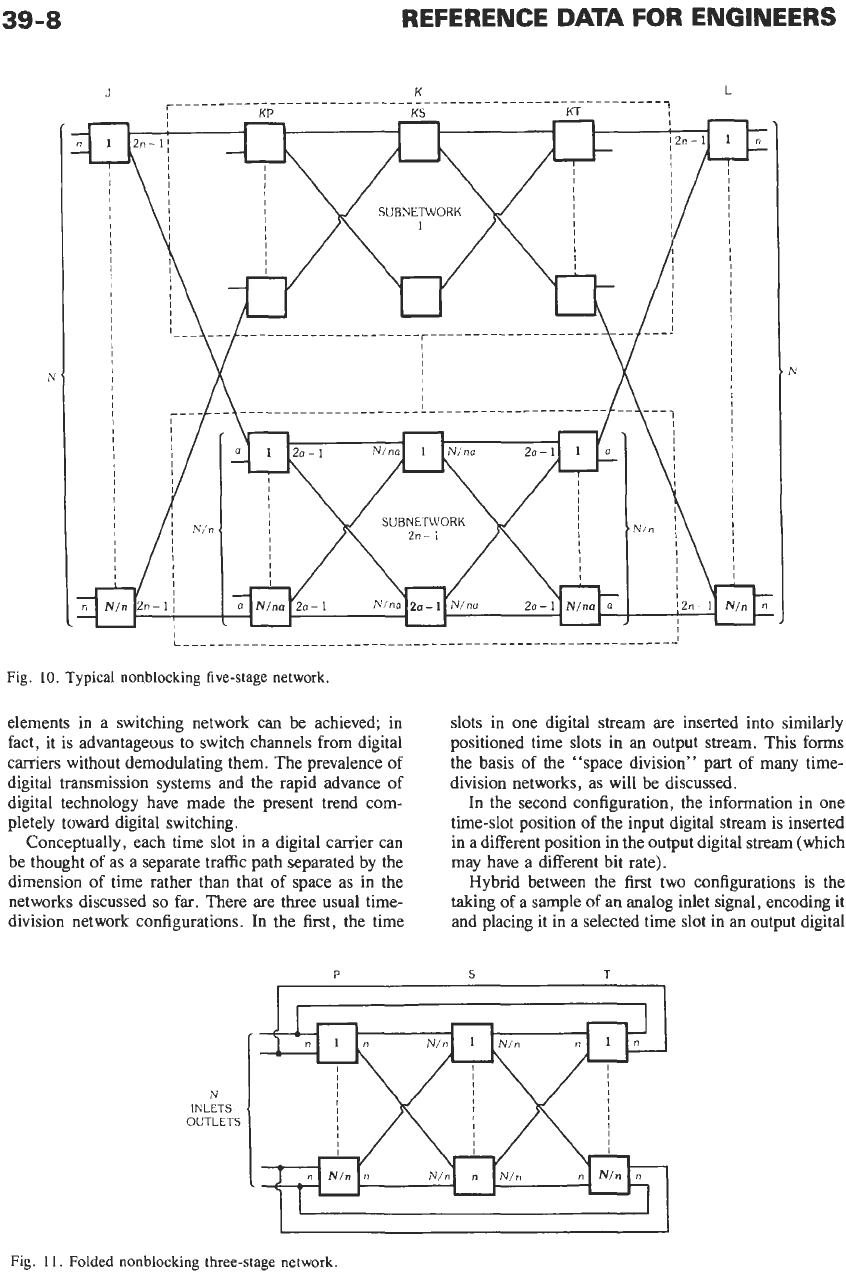
39-8
REFERENCE
DATA
FOR ENGINEERS
Fig.
10.
Typical nonblocking five-stage network.
elements in a switching network can be achieved; in
fact, it is advantageous to switch channels from digital
carriers without demodulating them. The prevalence of
digital transmission systems and the rapid advance of
digital technology have made the present trend com-
pletely toward digital switching.
Conceptually, each time slot in a digital carrier can
be thought of as a separate traffic path separated by the
dimension of time rather than that of space as in the
networks discussed
so
far. There are three usual time-
division network configurations. In the first, the time
N
OUTLETS
INLETS-
1
P
N
slots in one digital stream are inserted into similarly
positioned time slots in an output stream. This forms
the basis
of
the “space division” part of many time-
division networks, as will be discussed.
In the second configuration, the information in one
time-slot position of the input digital stream is inserted
in a different position in the output digital stream (which
may have a different bit rate).
Hybrid between the first two configurations is the
taking of a sample of an analog inlet signal, encoding it
and placing it in a selected time slot in an output digital
S
7
Fig.
11.
Folded
nonblocking
three-stage network.
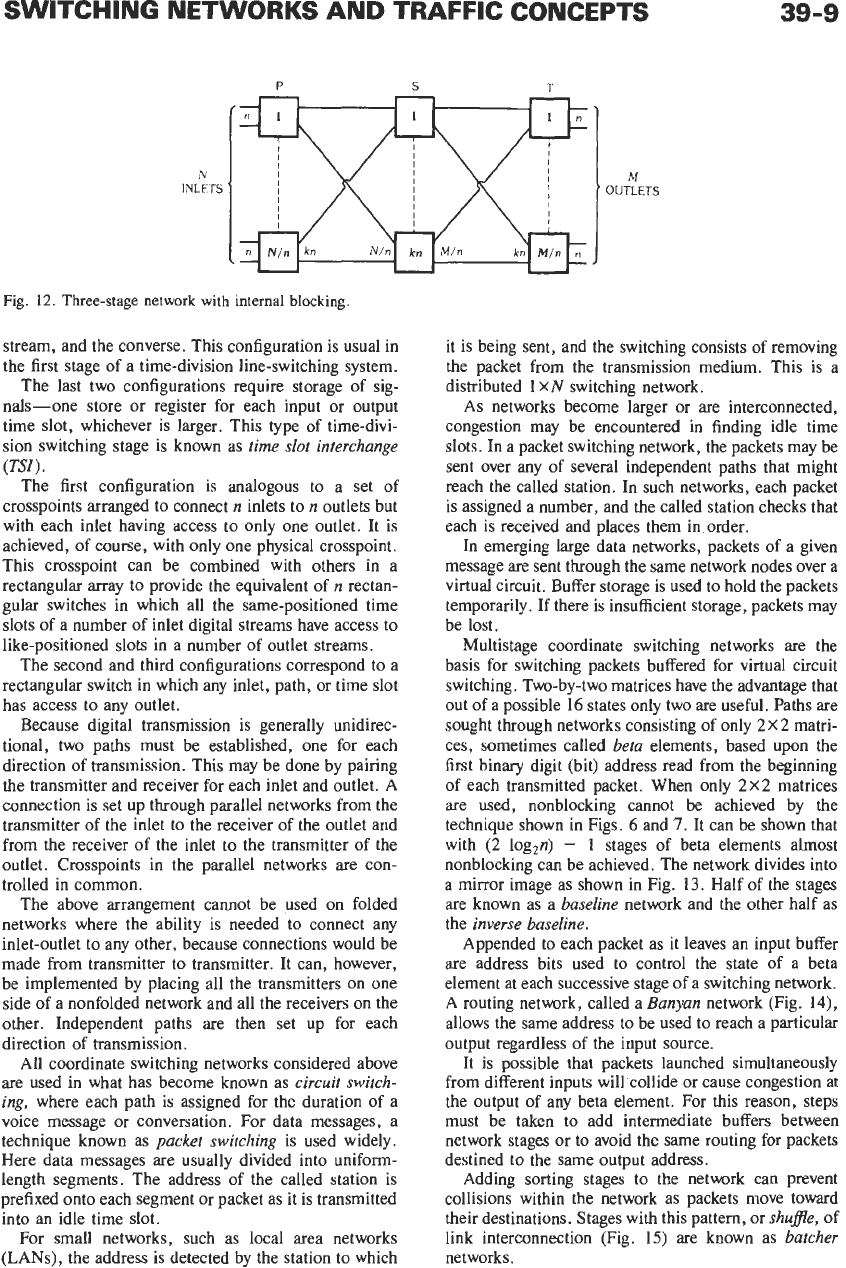
39-9
P
S
T
N
INLETS
Fig.
12.
Three-stage network
with
internal blocking.
stream, and the converse. This configuration is usual in
the first stage of a time-division line-switching system.
The last two configurations require storage of sig-
nals-one store
or
register for each input or output
time slot, whichever
is
larger. This type of time-divi-
sion switching stage is known as
time slot interchange
(TSZ).
The first configuration is analogous to a set of
crosspoints arranged to connect
n
inlets
to
n
outlets but
with each inlet having access to only one outlet. It is
achieved, of course, with only one physical crosspoint.
This crosspoint can be combined with others in a
rectangular array
to
provide the equivalent of
n
rectan-
gular switches in which all the same-positioned time
slots of a number of inlet digital streams have access to
like-positioned slots in a number of outlet streams.
The second and third configurations correspond to a
rectangular switch in which any inlet, path, or time slot
has access to any outlet.
Because digital transmission is generally unidirec-
tional, two paths must be established, one for each
direction of transmission. This may be done by pairing
the transmitter and receiver for each inlet and outlet. A
connection is set up through parallel networks from the
transmitter of the inlet to the receiver of the outlet and
from the receiver of the inlet to the transmitter of the
outlet. Crosspoints in the parallel networks
are
con-
trolled in common.
The above arrangement cannot be used
on
folded
networks where the ability is needed to connect any
inlet-outlet to any other, because connections would be
made from transmitter to transmitter. It can, however,
be implemented by placing all the transmitters on one
side of a nonfolded network and all the receivers
on
the
other. Independent paths are then set
up
for each
direction
of
transmission.
All coordinate switching networks considered above
are
used in what has become known as
circuit switch-
ing,
where each path is assigned for the duration of a
voice message or conversation. For data messages, a
technique known as
packet switching
is used widely.
Here data messages are usually divided into uniform-
length segments. The address
of
the called station is
prefixed onto each segment or packet as it is transmitted
into an idle time slot.
For small networks, such as local area networks
(LANs),
the address is detected by the station to which
M
’
OUTLETS
it is being sent, and the switching consists of removing
the packet from the transmission medium. This is a
distributed
1
XN
switching network.
As
networks become larger or are interconnected,
congestion may be encountered in finding idle time
slots. In a packet switching network, the packets may be
sent over any of several independent paths that might
reach the called station. In such networks, each packet
is
assigned a number, and the called station checks that
each is received and places them in order.
In emerging large data networks, packets of a given
message are sent through the same network nodes over a
virtual circuit. Buffer storage is used to hold the packets
temporarily. If there is insufficient storage, packets may
be lost.
Multistage coordinate switching networks are the
basis for switching packets buffered for virtual circuit
switching. Two-by-two matrices have the advantage that
out of a possible 16 states only two are useful. Paths are
sought through networks consisting
of
only
2X 2
matri-
ces, sometimes called
beta
elements, based upon the
first binary digit (bit) address read from the beginning
of each transmitted packet. When only
2
X
2
matrices
are used, nonblocking cannot be achieved by the
technique shown in Figs. 6 and
7.
It can be shown that
with
(2
log,n)
-
1
stages of beta elements almost
nonblocking can be achieved. The network divides into
a mirror image as shown in Fig. 13. Half of the stages
are known as a
baseline
network and the other half as
the
inverse baseline.
Appended to each packet as it leaves an input buffer
are address bits used
to
control the state of a beta
element at each successive stage of a switching network.
A routing network, called a
Banyan
network (Fig.
14),
allows the same address to be used to reach a particular
output regardless of the input source.
It
is
possible that packets launched simultaneously
from different inputs will collide or cause congestion at
the output of any beta element. For this reason, steps
must
be taken to add intermediate buffers between
network stages or to avoid the same routing for packets
destined to the same output address.
Adding sorting stages to the network can prevent
collisions within the network as packets move toward
their destinations. Stages with this pattern, or
shufle,
of
link interconnection (Fig.
15)
are
known as
butcher
networks.
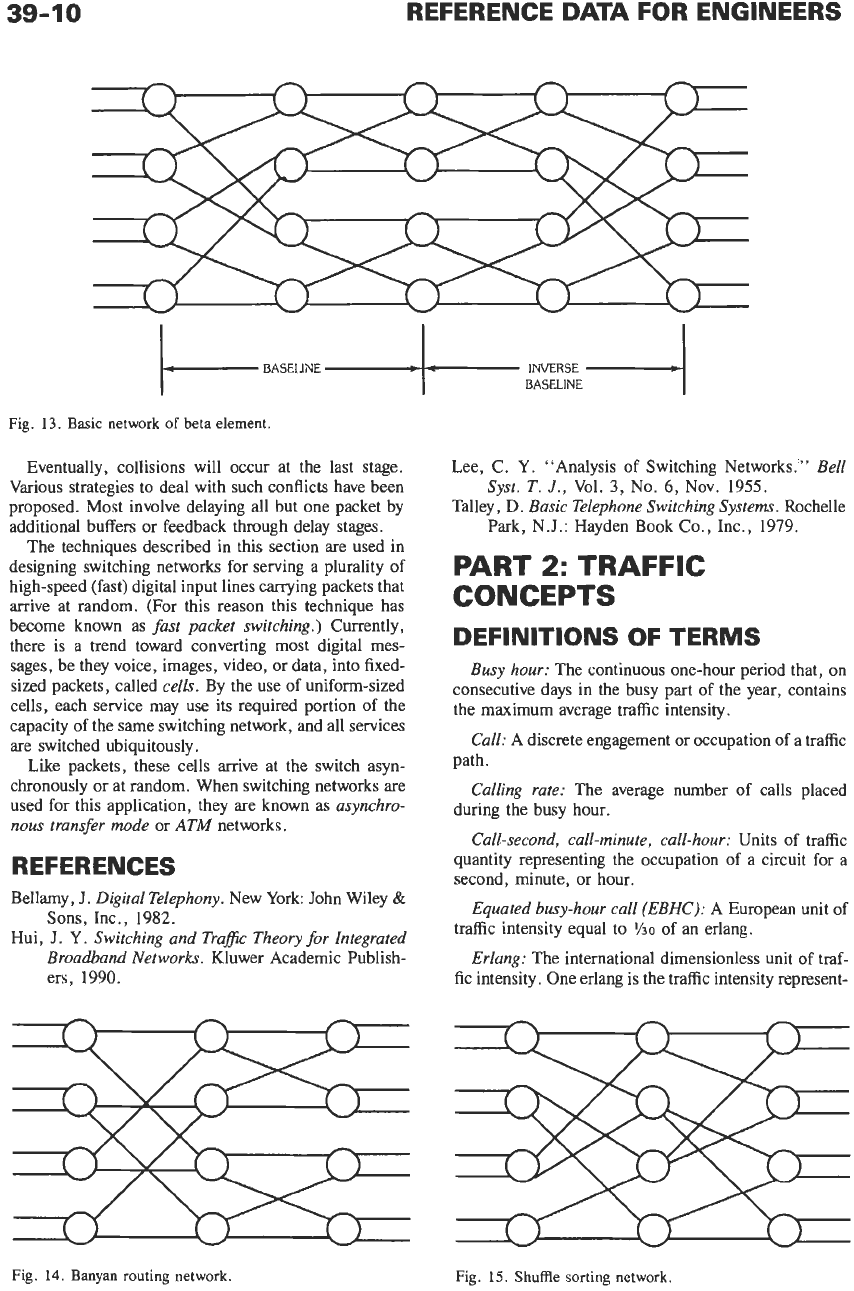
39-10
REFERENCE
DATA
FOR ENGINEERS
Fig.
13.
Basic
network
of
beta element.
Eventually, collisions will occur at the last stage.
Various strategies to deal with such conflicts have been
proposed. Most involve delaying all but one packet by
additional buffers or feedback through delay stages.
The techniques described in this section are used in
designing switching networks for serving a plurality of
high-speed (fast) digital input lines carrying packets that
arrive at random. (For this reason this technique has
become known as
fast packet switching.)
Currently,
there is a trend toward converting most digital mes-
sages, be they voice, images, video, or data, into fixed-
sized packets, called
cells.
By
the use of uniform-sized
cells, each service may use its required portion of the
capacity of the same switching network, and all services
are
switched ubiquitously.
Like packets, these cells arrive at the switch asyn-
chronously or at random. When switching networks
are
used for this application, they are known as
asynchro-
nous
transfer mode
or
ATM
networks.
REFERENCES
Bellamy,
J.
Digital Telephony.
New York John Wiley
&
Sons, Inc.,
1982.
Hui,
J.
Y.
Switching and Traffic Theory for Integrated
Broadband Networks.
Kluwer Academic Publish-
ers,
1990.
Lee, C. Y. “Analysis
of
Switching Networks.”
Bell
Syst.
T.
J.,
Vol.
3,
No.
6,
Nov.
1955.
Talley
,
D.
Basic Telephone Switching Systems.
Rochelle
Park, N.J.: Hayden Book Co., Inc.,
1979.
PART
2:
TRAFFIC
CONCEPTS
DEFINITIONS OF TERMS
Busy hour:
The continuous one-hour period that,
on
consecutive days in the busy part
of
the year, contains
the maximum average traffic intensity.
Call:
A discrete engagement
or
occupation of a traffic
path.
Calling rate:
The average number of calls placed
during the busy hour.
Call-second, call-minute, call-hour:
Units of traffic
quantity representing the occupation of a circuit for a
second, minute, or hour.
Equated busy-hour call (EBHC):
A European unit of
traffic intensity equal to
1/30
of
an erlang.
Erlang:
The international dimensionless unit of traf-
fic intensity. One erlang
is
the traffic intensity represent-
Fig.
14.
Banyan
routing network. Fig.
15.
Shuffle sorting network.
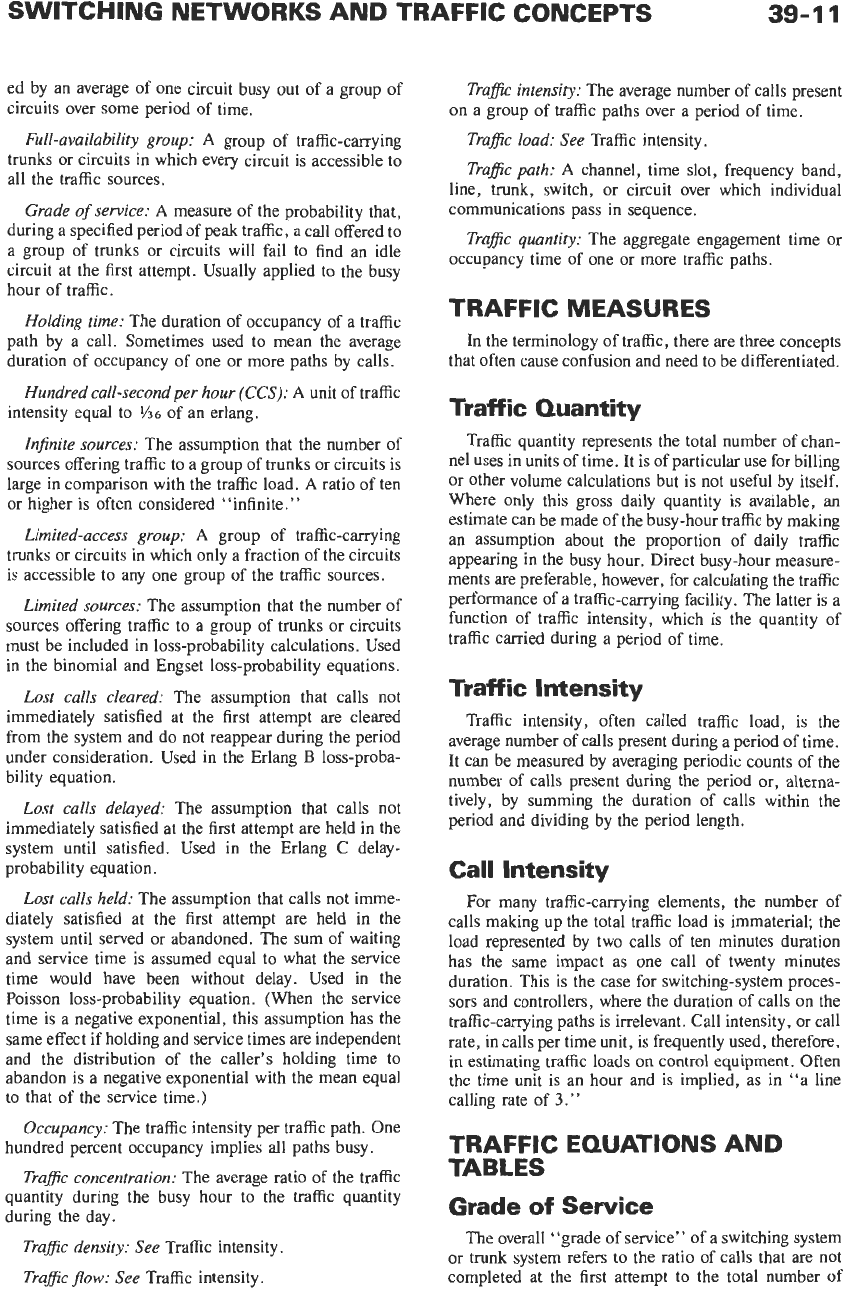
39-1
1
ed by an average of one circuit busy out of a group of
circuits over some period of time.
Full-availability group:
A
group of traffic-carrying
trunks or circuits in which every circuit is accessible to
all the traffic sources.
Grade
of
service:
A
measure of the probability that,
during a specified period of peak traffic, a call offered to
a group of trunks or circuits will fail to find an idle
circuit at the first attempt. Usually applied to the busy
hour of traffic.
Holding time:
The duration of occupancy of a traffic
path by a call. Sometimes used to mean the average
duration of occupancy of one or more paths by calls.
Hundred call-secondper hour
(CCS):
A
unit of traffic
intensity equal to
%6
of an erlang.
ZnJnite sources:
The assumption that the number of
sources offering traffic to a group of trunks or circuits is
large in comparison with the traffic load.
A
ratio of ten
or higher
is
often considered “infinite.”
Limited-access group:
A
group of traffic-carrying
trunks
or
circuits in which only a fraction of the circuits
is accessible to any one group of the traffic sources.
Limited sources:
The assumption that the number of
sources offering traffic to a group of trunks or circuits
must be included in loss-probability calculations. Used
in the binomial and Engset loss-probability equations.
Lost calls cleared:
The assumption that calls not
immediately satisfied at the first attempt are cleared
from the system and do not reappear during the period
under consideration. Used in the Erlang
B
loss-proba-
bility equation.
Lost calls delayed:
The assumption that calls not
immediately satisfied at the first attempt are held in the
system until satisfied. Used in the Erlang C delay-
probability equation.
Lost calls held:
The assumption that calls not imme-
diately satisfied at the first attempt are held in the
system until served or abandoned. The sum of waiting
and service time is assumed equal to what the service
time would have been without delay. Used in the
Poisson loss-probability equation. (When the service
time is a negative exponential, this assumption has the
same effect if holding and service times are independent
and the distribution
of
the caller’s holding time to
abandon is a negative exponential with the mean equal
to that
of
the service time.)
Occupancy:
The traffic intensity per traffic path. One
hundred percent occupancy implies all paths busy.
Trafic concentration:
The average ratio of the traffic
quantity during the busy hour to the traffic quantity
during the day.
Trafic density: See
Traffic intensity.
Trafic
Jlow:
See
Traffic intensity.
Trafic intensity:
The average number of calls present
Trafic load: See
Traffic intensity.
Trafic path:
A
channel, time slot, frequency band,
line, trunk, switch, or circuit over which individual
communications pass in sequence.
Tra$c quantity:
The aggregate engagement time or
Occupancy time of one or more traffic paths.
on
a group of traffic paths over a period of time.
TRAFFIC MEASURES
In the terminology of traffic, there are three concepts
that often cause confusion and need to be differentiated.
Traffic Quantity
Traffic quantity represents the total number of chan-
nel uses in units of time. It is of particular use for billing
or other volume calculations but is not useful by itself.
Where only this gross daily quantity is available,
an
estimate can be made of the busy-hour traffic by making
an assumption about the proportion of daily traffic
appearing in the busy hour. Direct busy-hour measure-
ments are preferable, however, for calculating the traffic
performance of a traffic-carrying facility. The latter is a
function of traffic intensity, which is the quantity of
traffic carried during a period of time.
Traffic Intensity
Traffic intensity, often called traffic load, is the
average number of calls present during a period of time.
It can be measured by averaging periodic counts of the
number of calls present during the period or, alterna-
tively, by summing the duration of calls within the
period and dividing by the period length.
Call
Intensity
For many traffic-canying elements, the number of
calls making up the total traffic load is immaterial; the
load represented by two calls of ten minutes duration
has the same impact as one call of twenty minutes
duration. This is the case for switching-system proces-
sors and controllers, where the duration of calls on the
traffic-carrying paths is irrelevant. Call intensity, or call
rate, in calls per time unit, is frequently used, therefore,
in estimating traffic
loads
on
control equipment. Often
the time unit is an hour and is implied, as in “a line
calling rate of
3.”
TRAFFIC EQUATIONS AND
TABLES
Grade
of
Service
The overall “grade of service” of a switching system
or
trunk system refers to the ratio
of
calls that are
not
completed at the first attempt to the total number of
